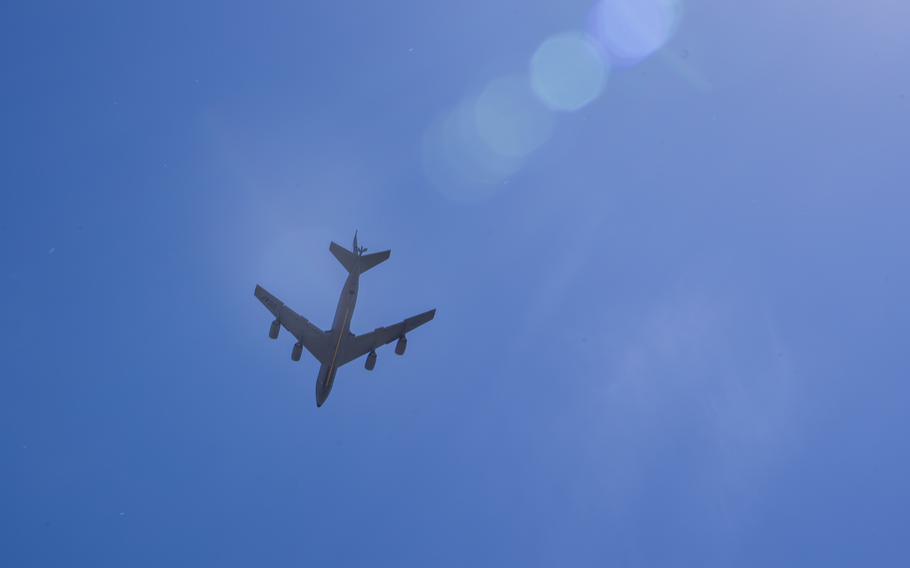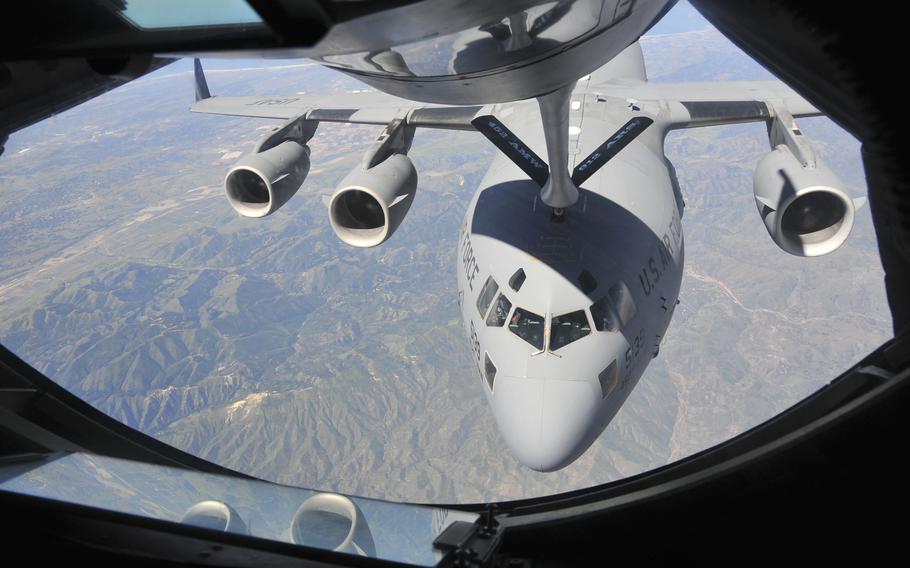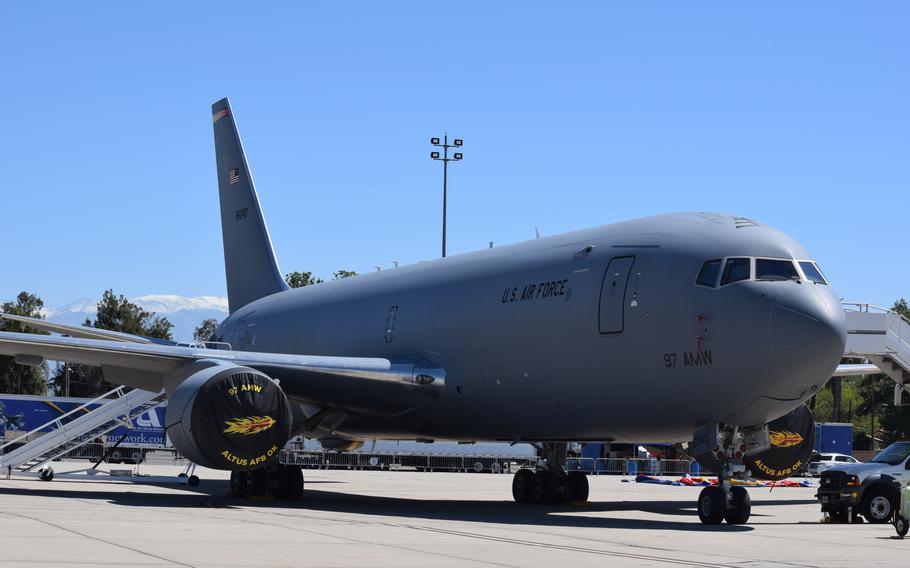
A KC-135 Stratotanker assigned to the 452nd Air Mobility Wing’s 336th Air Refueling Squadron performs a flyover in Moreno Valley, Calif., May 14, 2020. (Keith James/U.S. Air Force)
MARCH AIR RESERVE BASE, Calif. (Tribune News Service) — Marlo Fleck might be the world’s most highly trained gas station attendant.
That’s how Fleck, a 37-year-old U.S Air Force Reserve major, jokingly describes her job flying Boeing KC-135 Stratotankers assigned to the 452nd Air Mobility Wing at March Air Reserve Base near Riverside.
The tankers, which Fleck called “airborne Shell station(s),” refuel military aircraft in midair, extending their range and how long they can stay airborne.
In service for six decades, the Air Force’s 396 KC-135s — March has 12 of them — are being phased out and replaced by the newer, more advanced Boeing KC-46A Pegasus. The U.S. military has ordered 179 KC-46As to be delivered between now and 2029.
Twelve KC-46As, each costing $176 million, will start arriving at March as soon as late 2024 to replace KC-135s that have been at the base 29 years, said Jamil Dada, a longtime community liaison with March.
It’s a big deal for a base that dates to World War I and shed thousands of jobs during a 1990s downsizing. Getting the new planes shields March from closure “for 30 to 40 years,” Dada said.
March already injects $800 million into the local economy through everything from gas purchases and hotel stays to hiring civilian contractors, Dada said. The KC-46As represent another $3 billion investment, he said.
While technically a reserve base, March, which is sandwiched between Riverside, Moreno Valley and Perris in western Riverside County, is as busy as many active-duty bases, Dada said.
Besides the tankers, March also is home to F-15 fighter jets, C-17 cargo planes, Predator drones, the 4th Air Force’s headquarters and Defense Media Activity, which runs the Armed Forces Network.
With looming threats from North Korea and China, the Pentagon “is starting to pay more attention” to March and the base could become valuable in the event of a Pacific conflict, Dada said.
March’s KC-135s can be sent anywhere in the world. Fleck, who’s been flying KC-135s for 13 years — almost five of them at March — said she’s been deployed to refuel aircraft in the Iraq and Afghanistan conflicts “several times.”
“I don’t think that there’s anything that can be refueled that I haven’t refueled,” she said.
The list includes C-5 cargo planes, B-1 bombers, F-22 fighters and foreign warplanes like European-built Tornadoes and French Mirages.

A U.S. Air Force C-17 Globemaster III from the 729th Airlift Squadron, and a KC-15 Stratotanker from the 336th Air Refueling Squadron, perform an aerial refueling mission as part of a civilian media flight during Air Fest 2016, March Air Reserve Base, Calif., April 15, 2016. (Donald Allen/U.S. Air Force)
Planes easier to fly, harder to ride
The first thing one notices on board a KC-135 is that it’s not built for comfort. Cushionless jump seats line both sides of a spartan interior with slick gray floors.
It’s not much better in the cockpit.
“I’m not sure that the word or concept of ergonomics existed in the fifties” when the KC-135 entered service, Fleck said.
“You’re kind of always uncomfortable. And so the longer the flight, the more your back and stuff hurts. You have to get up a lot and go do some pushups or whatever just to get your body moving again.”
On the plus side, flying the KC-135 is “pretty systematically straightforward because it was designed and built in the late (1940s) and the early (1950s),” Fleck said. “So if you imagine where we were technologically at that point in time, things were a lot simpler.”
A tube runs the length of the plane’s left side to the rear, where the boom operator — the person responsible for connecting the plane’s refueling boom, or extendable refueling pipe, to other airplanes — lies down stomach-first.
“Literally they lay down on the job,” Fleck said. “We like to kind of make fun of them (for that). But in all fairness, there’s a lot of technical knowledge with what they do … the boom operators really take over and they get on the radio because they’re the ones that actually have the visual on the (refueling plane).”
While the boom operator uses a joystick to connect the 48-foot-long boom with a plane needing a fill-up, Fleck and a co-pilot keep the KC-135 steady, avoiding any jerking movements or airspeed changes as the tanker and its customer try to hook up.
“It’s a very choreographed standardized process,” Fleck said. “There are certain procedures and certain airspeeds and certain emergency protocols that we have if things don’t go quite as we expected them to go.”
Refueling relies on everyone being on the same page to avoid midair collisions.
“Everyone knows exactly (what to do)” if they hear “‘break away, break away, break away,’” Fleck said.
Fighters are easier to refuel than slower and less maneuverable cargo planes, said Fleck, who spent about 20 months learning to fly the KC-135 after graduating from the U.S. Air Force Academy.
Flying brings long, odd hours
Every phase of the KC-135’s flight has a checklist, Fleck said.
“That’s basically why the military is good at what we do,” she said. “You could fly with somebody different every single day. But what goes on in the aircraft should be exactly the same because everything is very checklist oriented.”
Flying the KC-135 means committing to an unconventional schedule.
Fleck’s recent mission in Germany started with a flight from March to an East Coast base before a flight that took off the following night at midnight East Coast time.
“(We) flew all night, got to Germany, spent about a day on the ground … It was night for our normal body clocks,” she said. “Just in the span of like four days we flew (during the) day, then we flew two nights, then we woke up and flew (in the) morning.”
Fleck, who has been in the air as long as 17 hours straight, added: “It’s not easy flip-flopping back and forth like that. But it’s really kind of what we signed up for … So we try to do our due diligence just to make sure we’re staying safe and getting enough rest.”
Finding things to talk about during long flights can be challenging, Fleck said. But as a flight instructor, she has a secret weapon.
“I like to get my crew engaged,” she said. “We’ll … go back through the books and I might ask them some questions on what we call general knowledge of the aircraft. And if they don’t know the answer, I’ll say ’Well, let’s get the book out and let’s look it up.’”
New planes are bigger and bulletproof

A KC-46 Pegasus tanker at March Field in California on April 21, 2023. (Roy A. Santana/U.S. Air Force)
Modeled after the Boeing 767 airliner, the new KC-46A has a larger wingspan and two fewer engines than the KC-135.
It carries more fuel than its predecessor and can refuel up to three planes at once — the KC-135 can only refuel one plane at a time. Compared to the KC-135, the KC-46A can carry more cargo, passengers and patients needing to be medevaced.
The KC-46A also has defensive measures the KC-135 lacks, such as lasers that can ward off heat-seeking missiles.
To handle the KC-46As, March will need “new equipment and new infrastructure,” Dada said. New on-base housing must be built for pilots on alert status who need to be airborne in three minutes, he added.
Last year, the Air Force announced March was the “preferred destination” for 12 KC-46As.
“I can’t guarantee it on paper but … I’m 90% certain that we’re on track,” Dada said.
March is still the preferred destination for the KC-46s “as far as we know,” Wendy Day, the base’s chief of media engagement, said via email.
As for Fleck, she’ll learn to fly the KC-46As in the next couple years.
“Certainly (the new planes will have) all the creature comforts and certainly upgraded engines and avionics and cockpit,” she said. “It’s probably night and day, light years different.”
She added: “I’m excited. I think it’s time for just an update.”
©2023 MediaNews Group, Inc.
Visit The Press-Enterprise (Riverside, Calif.) at pe.com.
Distributed by Tribune Content Agency, LLC.